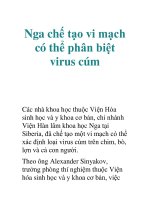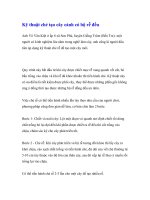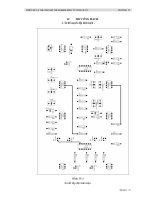Kỹ thuật chế tạo vi mạch
Bạn đang xem bản rút gọn của tài liệu. Xem và tải ngay bản đầy đủ của tài liệu tại đây (352.69 KB, 39 trang )
EE 105 Fall 2000 Page 1 Week 2
IC Fabrication Technology
* History:
1958-59: J. Kilby, Texas Instruments and R. Noyce, Fairchild
* Key Idea:batch fabrication of electronic circuits
An entire circuit, say 10
7
transistors and 5 levels of wiring can be made in and
on top of a silicon crystal by a series of process steps similar to printing. More
than 100 copies of the circuit are typically made at the same time.
The silicon crystal is called a wafer.
* Results:
1. Complex systems can be fabricated reliably
2. Cost per function drops as the process improves (e.g., finer printing),
since the cost per processed wafer remains about the same
200 mm
< 1 mm
cut indicates crystal orientation
EE 105 Fall 2000 Page 2 Week 2
Lithography: the Wafer Stepper
The mask is imaged on a photosensitive film (photoresist) that coats the wafer and
then the wafer is scanned (“stepped”) to the next position
Mask pattern is aligned automatically to patterns on the underlying layers, to a
precision of < 0.1 micron.
mask
lens
silicon
wafer
wafer scan direction
unexposed
dice
exposed
dice
ultraviolet light illumination
field area is actually
opaque
with photo-
(coated
resist)
EE 105 Fall 2000 Page 3 Week 2
Lithography:
Exposure, Development, and Pattern Transfer
* Simple example of a mask layout and a process (or recipe)
* Mask layout is the set of patterns on the glass plates for patterning the layers
(one in this case)
* Process is the sequence of fabrication steps
* Visualize by generating cross sections through the structure as it is built up
through the process
x (µm)
0 1 2 3 4 5 6
A
A
B
B
Mask
Pattern
EE 105 Fall 2000 Page 4 Week 2
Photolithography Process
* Photoresist dissolves in alkaline solutions (called “developer”) when it has been
exposed to UV light (positive photoresist)
* Pattern transfer “subroutine”
0. Clean wafer
1. Spin-coat the wafer with 1 µm of photoresist; pre-bake to drive off solvents
2. Expose the wafer in the wafer stepper
3. Develop the image, bake the resist to toughen it against etching
4. Transfer pattern to underlying film by selectively etching it*
5. Remove photoresist using an oxygen plasma or organic solvents
* subtractive patterning process (usual case EE 105)
Silicon substrate
photoresist
1 µm
bottom of
wafer is *not* shown
1 mm
silicon wafer
factor of 1000!
EE 105 Fall 2000 Page 5 Week 2
Visualizing Exposure
Omit lens and show UV light going through mask onto wafer
Two-dimensional cross sections are easier than 3D perspective views (for most)
A-A cross section
Silicon substrate
x (µm)
0 1 2 3 4 5 6
glass
mask
A
A
EE 105 Fall 2000 Page 6 Week 2
Development
Two-dimensional cross sections are easier than 3D perspective views (for most)
A-A cross section
Silicon substrate
x (µm)
0 1 2 3 4 5 6
glass
mask
A
A
EE 105 Fall 2000 Page 7 Week 2
Development
Two-dimensional cross sections are easier than 3D perspective views (for most)
B-B cross section
Silicon substrate
x (µm)
0 1 2 3 4 5 6
glass
mask
B
B
EE 105 Fall 2000 Page 8 Week 2
Process Flow in Cross Sections
* Process (simplified)
0. Clean wafer in nasty acids (HF, HNO
3
, H
2
SO
4
, )
1. Grow 0.5 µm of SiO
2
by putting the wafer in a furnace at 1000
o
C with O
2
(pattern transfer subroutine)
P1. Coat the wafer with 1 µm of photoresist
P2. Expose and develop the image and bake the resist to get rid solvent and to
make it tougher
P3. Put wafer in a plasma etcher: fluorine ions in plasma etch SiO
2
without
significant etching of photoresist or silicon
P4. Put wafer in a plasma stripper: oxygen ions remove photoresist and leave
SiO
2
untouched.
* Mask Pattern
A
A
0
1
2
3
y [µm]
EE 105 Fall 2000 Page 9 Week 2
Process Flow in Cross Sections
* After Step 1 (SiO
2
growth):
Silicon substrate
thermal SiO
2
0.5 µm
original silicon
surface
original surface
EE 105 Fall 2000 Page 10 Week 2
Process Cross Sections (cont.)
* After Step P2: photoresist has been developed from regions exposed to UV
through the image of the clear areas of the mask
Silicon substrate
thermal SiO
2
0.5 µm
1 µm photoresist
0
1
2
3
y [µm]
A
A
0
1
2
3
y [µm]
EE 105 Fall 2000 Page 11 Week 2
Silicon substrate
thermal SiO
2
0.5 µm
1 µm photoresist
0
1
2
3
y [µm]
EE 105 Fall 2000 Page 12 Week 2
Process Cross Sections (cont.)
* Cross section after step P3 (oxide etching in fluorine plasma)
* Cross section after step P4 (resist stripping)
Silicon substrate
thermal SiO
2
1 µm photoresist
0
1
2
3
y [µm]
Silicon substrate
thermal SiO
2
0
1
2
3
y [µm]
EE 105 Fall 2000 Page 13 Week 2
IC Processes: Ion Implantation
* How to introduce dopants into silicon?
1. wafers are purchased from the vendor with specified substrate doping
2. ion implantation: most common way to add dopants to the surface of wafer
* Ion implanter
ions are generated, accelerated, and impact the wafer in a collimated beam
the beam is raster-scanned over the wafer (like the electron beam in a CRT)
energies range from 10 keV to several MeV range of ions in silicon is up to
around 1 µm (max)
EE 105 Fall 2000 Page 14 Week 2
Ion Tracks in Silicon
* Each ion makes a series of collisions as it is stopped by the silicon crystal
silicon atoms are knocked out of their positions
* ion tracks (simulated) show that the ion density (cm
-3
) as a function of depth is a
probability distribution
* crystal order is destroyed by the implantation damage, but
this amorphous layer can be recrystallized by heating the wafer above 900
o
C
and most of the ions end up on lattice sites and function as donors and acceptors
the process of repairing the damage by heating the wafer is called annealing
from: S. M. Sze, VLSI
Wiley, 1989.
Technology, 2nd ed.,
EE 105 Fall 2000 Page 15 Week 2
Patterned Doping by Ion Implantation
* Dose = ion beam flux (number cm
-2
s
-1
) x time for implant units cm
-2
Example:
SiO
2
film masks the implant by preventing ions from reaching the underlying
silicon (assuming it’s thick enough)
> after implantation, the phosphorus ions are confined to a damaged region near
the silicon surface :
> Note: the P in the SiO
2
doesn’t change its properties significantly
SiO
2
N
a
= 10
15
cm
-3
phosphorus ions, dose Q
d
= 10
13
cm
-2
SiO
2
stops
N
a
= 10
15
cm
-3
P-implanted
layer
phosphorus
EE 105 Fall 2000 Page 16 Week 2
Patterned Doping by Ion Implantation (cont.)
* Annealing heals damage and also redistributes the ions (they spread farther into
the silicon crystal, depending how long and how high the annealing temperature)
x
j
is the junction depth and is the point where N
d
= N
a
* Details of N
d
(x): see EE 143. We will use the average concentration in the n-type
region for a given junction depth in EE 105.
* Average donor concentration in n-type layer N
d
= Q
d
/ x
j
n-type
x
p-type
SiO
2
phosphorus-doped
x
j
x
x
j
= 500 nm
N
d
(x)
10
15
2 x10
17
N
d
(average)
N
a
EE 105 Fall 2000 Page 17 Week 2
IC Materials and Processes
* Polycrystalline silicon (polysilicon):
1. silicon deposited from a gas at around 600
o
C, usually with dopants added
during the deposition process
2. not a single crystal, but made up of small crystallites (grains)
3. mobilities for holes and electrons are reduced because of the effects of the
boundaries between grains
4. used in transistors and for very short “wires” or interconnects
* Deposited oxides:
1. silicon dioxide deposited from a gas at temperatures from 425
o
C to 600
o
C
2. these oxides are known as “CVD” oxides for “chemical vapor deposition”
3. electrical properties are inferior to thermally grown oxides
4. used as an insulating layer between polysilicon and metal layers
* Metals:
1. aluminum is the standard “wire” for ICs, but copper is beginning to be used
2. thin layers of special metals (Ti, W) to prevent Al from reacting with silicon
EE 105 Fall 2000 Page 18 Week 2
IC Process
In order to make an IC, we need
1. the mask patterns (up to 30)
2. the sequence of fabrication steps (the process or recipe) (up to 500)
Problem:
Designing the mask patterns for the IC structures using CAD requires being able to
see the overlaps between patterns for several masks at once
What happens when a mask is almost all black?
CAD layout: “draw the holes”
mask pattern on glass plate
EE 105 Fall 2000 Page 19 Week 2
Process Flow Example
* Three-mask layout:
* Process (highly simplified):
1. Grow 500 nm of thermal oxide and pattern using oxide mask
2. Implant phosphorus and anneal
3. Deposit 600 nm of CVD oxide and pattern using contact mask
4. Sputter 1 µm of aluminum and pattern using metal mask
** note that “pattern using xxx mask” involves photolithography
(including alignment to earlier patterns on the wafer), as well as
etching using a plasma or “wet” chemicals, and finally, stripping
photoresist and cleaning the wafer.
EE 105 Fall 2000 Page 20 Week 2
Cross Sections A - A
* Shown on layout; only draw top few µm of the silicon wafer
* Technique: keep track of dark/light field label for each mask and be careful to be
consistent on what is added or etched in each step
A
A
A
A
A
A
EE 105 Fall 2000 Page 21 Week 2
Cross Sections A - A and B - B
* Different cross section at Al-silicon contact
A
A
B
B
B
B
B
B
EE 105 Fall 2000 Page 22 Week 2
n-Type Silicon Resistors
* Current is current density times cross sectional area:
Thus, the resistance of the Si resistor is given by
where ρ
n
is the resistivity[units: Ω-cm]
* Silicon resistivities:
500 Ω-cm to 5 mΩ-cm for doping concentrations from 10
13
to 10
19
cm
-3
Thus,
AtW
×
=
I σ
n
V
L
A
σ
n
A
L
V==
R ρ
n
L
A
(the familiar resistor equation)==
R R
sq
L
W
⋅≡=
EE 105 Fall 2000 Page 23 Week 2
Sheet Resistance
The sheet resistance is under the control of the process designer;
The number of squares is determined by the layout and is specified by the IC
designer.
Example:
For average doping levels of 10
15
cm
-3
to 10
19
cm
-3
and a typical layer thickness of
0.5 µm, the sheet resistance ranges from 100 kΩ/sq to 10 Ω/sq.
Typical sheet resistances:
R
R
sq
LW
⁄
()
=
n
+
polysilicon (t =500 nm) 20
Ω / square
aluminum (t = 1 µm)
0.07
silicided polysilicon 5
silicided source/drain diffusion
3
implanted layers in Si 10 to 10
5
EE 105 Fall 2000 Page 24 Week 2
Uncertainties in IC Fabrication
The precision of transistors and passive components fabricated using IC technology
is surprisingly, poor!
Sources of variations:
* ion implant dose varies from point to point over the wafer and from wafer to
wafer
* thicknesses of layers after annealing vary due to temperature variations across
the wafer
* widths of regions vary systematically due to imperfect wafer flatness
(leading to focus problems) and randomly due to raggedness in the photoresist
edges after development
* etc., etc.
EE 105 Fall 2000 Page 25 Week 2
Linewidth Uncertainties
* Due to lithographic and etching variation, the edges of a rectangle are
“ragged”—greatly exaggerated in the figure
* The width is
>
* Conclusion 1: wider resistors have smaller normalized uncertainty (since δ is
independent of width)
* Conclusion 2:the length L >> W and so its normalized uncertainty is negligible
compared to that of W
WW
δ
2
±
δ
2
± W δ±== WW1
δ
W
±
W 1 ε
W
±()==









